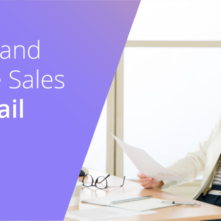Are you thinking, “Should I leave a voicemail? Nobody ever calls back! Am I doing something wrong? Why aren’t people calling me back? Can I leave a better voicemail?”
Don’t worry, you’re not alone… and you aren’t wrong.
A good 90% of our outbound calls end in voicemails and less than 3% are actually returned. Oh boy, math time. That means up to 225 voicemails left every week if I’m making 50 calls a day. And only 7-8 potential clients calling me back. More bad news: That’s because your voicemails are probably bad (sorry).
Frankly, most voicemails aren’t great. In fact, voicemails are the one time I advocate for a script. Actually, 4 scripts. After 15 years of teaching phone sales, we’ve found 4 voicemails that consistently get more calls back. We’re talking, double to triple more. Ready for the math? That means 14-23 calls back in a week instead of 8. Dude, 14 more conversations every week! That’s like getting a bonus day of selling time every week, for only the cost of changing up a voicemail. Yup, it’s literally that easy.
WATCH: How To Leave A Sales Voicemail That Gets Returned
You want to know the four types now, don’t you? You’re in luck. They’re all below with voicemail scripts.
Awesome Voicemail Script #1 – Value
Honestly, most voicemails are either all about the sales rep, why THEY are calling, and what THEY want. Or, they are vaguely veiled sales pitches. If you want to stand out, focus all of your attention on the customer instead. We call that So, What’s In It for Them or SWIIFT℠. Each potential customer wants to know if a call back is worth their time, so answer their unasked question immediately by pushing the value. Warning: if you push too hard, these can run the risk of sounding like a sales pitch. So, we find they work best for existing accounts or existing relationships. To use them with a new account, we suggest using it in combo with some mystery. Did you say mystery?
Value Voicemail Script:
Ted!? LB at Factor 8. (480) 555-2424. I’ve got three things that will save you time this quarter. Call me back for a five-minute run down. I’m at (480) 555-2424. Thanks!
Awesome Voicemail Script #2 – Mystery
Folks, FOMO is real. So let’s use it. Just a little mystery can have your potential clients saying to themselves, “Do I know them?”, “Why did they call me?” When you leave them wanting to know more it can translate into real-life callbacks. It may take guts, but when you use this strategy with the right customers, it will pay off!
Mystery Voicemail Script:
Ted!? It’s Lauren at (480) 555-2424. Call me back. Again, I’m at (480) 555-2424.
Awesome Voicemail Script #3 – Levers
A lever is information that proves your credibility, convinces them this isn’t a cold call, AND that you know your stuff! A lever can be account information, history, company knowledge, or a person – from either your company or theirs. The BEST lever is their boss.
Lever Voicemail Script #1: the Boss Lever
Hi Ted. Lauren with Factor 8. I’ve been talking with your boss, Amy, and she asked me to call you so I promised her that I would. Please reach me at (480) 555-2424. Again, Lauren with Factor 8 at (480) 555-2424. Thanks!
See the subtle implication that his boss wants him to talk to me? This voicemail script works if I call Amy and she says, “I don’t handle that, that’s Ted.” I say, “OK, I’ll call Ted,” and then we’re off to the races. I know, this is a special scenario, but use it as often as you can. For a regular lever, try something like:
Lever Voicemail Script #2: the Standard Lever
Hey Ted, LB here over at Factor 8. I’ve been working with your CXS team there for a few years. Will you please call me back? I’m at (480) 555-2424. Again, Lauren with Factor 8 at (480) 555-2424. Thanks!
Awesome Voicemail Script #4 – Urgency
If you’ve ever told someone that you’ll send an email anyway or that you’d call them back anyway, you’ve crushed the urgency in the situation. Reverse it instead! Ratchet up the intensity by adding a timeline and some energy (and even a little mystery). Try to get them to call back immediately after listening!
Urgency Voicemail Script:
Hey Ted. Lauren calling with Factor 8. I’m trying like crazy to reach you by end of day. Please call me at (480) 555-2424. Again, Lauren trying to get to you urgently. Call me back quickly please at (480) 555-2424.
Of course, we love the good combination message. Bringing a few different voicemail scripts together can create some real voicemail magic!
Combination Voicemail Script:
Ted? Lauren with Factor 8. Sue gave me your name. We need to talk today about your account so I can help save you some money. Please return my call at (480) 555-2424. That’s (480) 555-2424. Talk soon.
This script has urgency, mystery, a lever, AND value! (And you can still say it in under 10 seconds.) Now, that’s a powerful voicemail. I’d call back… wouldn’t you? I hope you found one that speaks to you – so more of your prospects will too.





 Most buyers are looking to buy.
Most buyers are looking to buy.